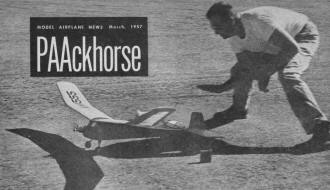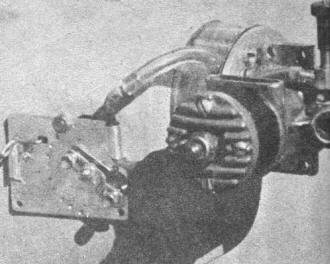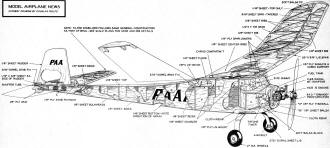|
PAA Load (pronounced 'payload') class competition was originally
sponsored by Pan American Airlines (PAA) in an effort to attract
young men into the realm of aviation, in hopes of bolstering its
workforce of mechanics, design engineers, loadmasters, maintenance
workers, and even administrators. It was similar to the way the
U.S. Navy used to sponsor and host the Nationals competition for
the Academy of Model Aeronautics (AMA). Part of the goal of PAA
Load events was to design and fly model airplanes that could carry
'cargo' of a specific size and weight for a certain length of time
using an airframe limited to regulation lifting surface area (wing
+ tail). In order to emphasize the relationship to 'real world'
aviation, a dummy pilot figure was (and still is) also required
(not implying, of course, that real-world pilots are dummies). See
chapter 14 of the
National Free Flight
Society rulebook for details on
PAA Load competition.
PAAckhorse
by Stanley D. Hill
For International Class competition in Pan American's PAA Load
Event, this superbly designed machine is a joy to build and fly.

Stanley Hill releases his PAAckhorse.
The PAAckhorse is a ship designed with attention to realism and
yet sacrifices none of its performance in achieving semi-scale appearance.
A good PAA-load model, like this one, should climb high with
it's pound of pay load, and then give up that altitude like a miser.
The requirements for a good PAA-load job pretty much set the
specifications for the designer. Not being able to go up like a
skyrocket with a pound of payload, clean design and a really excellent
glide are doubly important. A generous wing of 600 square inches
area, high aspect ratio, and an efficient turbulent-flow airfoil,
help the PAAckhorse to use the altitude gained as efficiently as
possible.
Perhaps second in importance to a PAA loader is a landing gear
that will not distort under load and ruin a take-off attempt with
a ground loop. The Cessna type gear of sheet dural has proved its
merit in handling the weight of RC models and it does equally well
at the similar job of getting a heavy PAA-load model "unstuck."
Features to note: Cessna type gear guarantees good take-offs;
a side-winder engine mounting minimizes exhaust-mess on airplane.
Without the pay load, the PAAckhorse will give the contest type
free flights a real run for their money. Then try a .19 or .23.
As in any contest ship, emphasis has been placed on simplicity
and rapid building with perhaps more than the usual attention given
to warp resistance. Once built, this one stays put.

The "sidewinder" engine mounting used is not necessary, of course,
but it does minimize oil collection on the ship, and priming and
battery attachment or compression adjustment are easier than in
the upright position. Without load or with .19 to .23 engines the
model is a potential winner in regular free flight events. The PAAckhorse
differs little from standard practice in construction or flying
and presents no problem in either one.

Home-made Lucite tank behind the motor mount
plate and details of Tatone's timer shown here.
Let's build it. You will note on the plan that all balsa other
than the wing spar is of light weight stock. This is necessary to
keep the weight of any PAA job down to a reasonable figure. If you
must use heavier wood, cut down on sheet thickness on the fuselage
sides and leading edges of the wing and stab. Construction is simple
enough that we'll mention only the few details that need special
note. It's best to build the PAA dummy before the fuselage in order
to use it as a guide in fitting bulkheads C and D.

Note that the wing leading edge is sharp and level with the bottom
of the wing while the stabilizer leading edge is rounded in the
usual manner with its entry point 1/8" above the lower surface.
I prefer to use silk covering for its strength. However, Jap tissue
and four coats of clear dope is adequate due to the model's structural
rigidity and is an ounce or so lighter than silk.
The fuel tank is cut from 1/2" Lucite (or laminations of 1/4"
using ethylene dichloride cement) with a coping saw, filed and sanded
with successively finer grades of sandpaper (2/0, 5/0, 8/0, 400)
and then polished with rubbing compound or buffed. Use an extra
crankcase gasket between the engine and the radial mount adaptor,
a ring gasket between the adaptor and the tank and a full disc gasket
between the tank and the firewall. If very high nitro content fuels
are used, drain the tank between flights to prevent softening the
plastic.

PAAckhorse Framework Cut-Away Drawing
For the 8 oz. cargo, a box of 1/8" balsa fitted to the compartment
works well. Load the box with BB shot and a little cement to a weight
of 8 oz., then cover with silk and dope as the rest of the model.
The loss of weight from evaporation of the cement will be made up
for by the silk and dope.
Flying any PAA loader is far easier than a hot FF job and the PAAckhorse
is no exception. With the load in place and the CG at 3 1/8" from
the trailing edge, trim for a flat glide with a gentle right turn
by varying stabilizer incidence and position of the whole rudder.
There should be no rudder offset, stab tilt being the only offset
on the entire ship. The flight pattern will be a straight climb
with a smooth transition into a right glide circle.
Proper adjustment of the landing gear is essential for good take-offs.
Push the model on the ground to see that it "tracks" straight. A
slight degree of tow-out is permissible and even recommended but
any degree of tow-in will cause a wing to drag on take-off. Don't
bother to put the prop on backwards for first tests. In fact, nearly
full power is OK right from the start.
The PAAckhorse performance on the allowed 20 sec. engine run
should give you a better than ever chance of bringing home some
of PAA's prizes.

PAAckhorse Plans
Notice:
The AMA Plans Service offers a
full-size version of many of the plans show here at a very reasonable cost. They
will scale the plans any size for you. It is always best to buy printed plans because
my scanner versions often have distortions that can cause parts to fit poorly. Purchasing
plans also help to support the operation of the
Academy of Model Aeronautics - the #1
advocate for model aviation throughout the world. If the AMA no longer has this
plan on file, I will be glad to send you my higher resolution version.
Try my Scale Calculator for
Model Airplane Plans.
Posted October 31, 2015
|